The word is also romanized monsutaa musume モンスター娘, and abbreviated monmosu もん娘. The musume 娘 part can mean "daughter," but in this case it means "girl." (see: suffix -kko っ娘)
- Origins
- Jingai Musume 人外娘
- Ajin 亜人
- Types & Examples
- Mamono Musume 魔物娘
- Monster Girl Encyclopedia
- What is Not a Monster Girl?
Origins
The fact that the Japanese word for "monster girl" uses the katakanization monstaa モンスター is rather telling. That's a word that's loaned from English, and surely Japanese has a number of other, more Japanese-y words that could've been used instead, like:- bakemono 化け物
Monster. - kaijuu 怪獣
Monster. - kaibutsu 怪物
Monster. - youkai 妖怪
Monster. (usually apparition.) - mamono 魔物
Monster. (usually demon.)
So why was monsutaa モンスター chosen? That's because the enemy "monsters" you fight against in the dungeons of RPG games—such as Dragon Quest, Shin Megami Tensei 真・女神転生, and so on—are generally called monsutaa モンスター, with the English loan-word.
Games
In particular, the original Shin Megami Tensei from decades ago already featured a number of a number of woman-like "monsters" you could fight against, and featured a system in which you could make such monsters become part of your nakama 仲間, i.e. join your party.(screenshot source: 【PC版】真・女神転生プレイ日記 - imortal.blog28.fc2.com)
If you're aware of the Fate fandom, you probably already know what that means: the monster girls you see today originate in fan-art, parodies, doujinshi, of monsters you fought against in those fantasy games.
Of course, you could invent your own fantasy monster, and monster girl, that doesn't actually exist in any actual game, but it usually surrounds the idea that: if it were a game, the monster girl would likely be one of the enemies you fight against, one of the "monsters."
This has happened in isekai light novels that parody fantasy games, such as Overlord, in which the main character gets sent to a virtual-reality fantasy MMORPG he played called Yggdrasil.
In Overlord, the main character's guild had NPC monsters defending their base that would fight against invading players. Some of those monsters are Albedo, Saltear, Mare, and Entoma. You could say those are all monster girls.
Mythology
The first games to feature monster girls didn't just make them up out of thin air.They are generally based on characters of legends of monsters that took the appearance of women, or of women that became monsters in legends.
- mochiifu モチーフ
"Motif." (katakanization of the French word.)
(refers to a thing which an art piece draws inspiration from. E.g. a common motif for monster girls are Greek mythology.)
Recurrence
This means that a same monster girl can end up becoming a recurring character in multiple, different games, because they all use that same legend as base.Gorgon, the snake-woman in Shin Megami Tensei, for example, also makes an appearance in Ogre Battle, a strategy game with fairies, mermaids, and other creatures that you can get as units in your army.
In the Castlevania series, however, which features a dozen of naked pixel-sprites of women-monsters that you have to violently stab to death, Gorgon ends up taking a form of a bull whose breathe turns you into stone. (what? This ain't no kawaii monster girl!)
This is because, in the Greek mythology, "Gorgon" was portrayed in various ways, and could even refer to Medusa with her snake-hair and petrifying gaze. So the exact form of the monster girl-or-not ends up varying from interpretation to interpretation, game to game.
Likewise, the name can vary too. For example, although harpies is usually called happii ハーピー, a katakanization of the English word "harpy," in Symphony of The Night harpies are called harupyuiai ハルピュイアイ instead, which's the katakanization of the Greek word for harpy: Ἅρπυιαι.
References Across Games
There are also cases of monster girls which are based on common game monsters, like slime girls.The slime isn't based on any mythology or legend, but it's a common enemy, and mascot, of the popular Dragon Quest franchise, as well as the weakest enemy in a number of other games, and the weakest enemy in a number of anime and manga which parody such games.
Jingai Musume 人外娘
The term jingai musume 人外娘, "non-human girl," is another term for monster girl in Japanese. The term "monster girl," in English, is often a translation of either monsutaa musume or jingai musume. But, in Japanese, there are differences between these two things:- jingai musume 人外娘
Non-human girl.
Any girl that's not human, literally.
(this is a very broad category.) - monsutaa musume モンスター娘
A girl that's based on a game monster.
So, sometimes, you have a monster-woman that has nothing to do with games or stopping the "hero," yuusha 勇者, from reaching the "demon lord," maou 魔王, or anything of sort.
So she's non-human, jingai 人外, but she isn't inspired by game "monsters," monsutaa モンスター.
But note that just because she isn't a game monster that doesn't mean she isn't evil. The jingai musume can be evil and go around murdering and devouring people. They can also not be evil and be part of the good guys. The fact they're jingai has nothing to do with that.
Generally speaking, monsutaa musume モンスター娘 is a sub-category of jingai musume 人外娘, since game monsters are pretty much always "non-human," jingai.
Kanji
By the way, jingai is written with the kanji for the words "person," hito 人, and "outside," 外, so "outside of [what you'd call a] person." Do not confuse with the same thing written backwards: gaijin 外人, "foreigner."Ajin 亜人
Another category of monster girl and sub-category of jingai are "demi-humans," ajin 亜人. Such characters are often mostly human, save for a small feature added to their human bodies.Angels, demons, elves, vampires, succubi, etc. often fall in this category, since they usually get pointy ears, wings on their backs, fangs, and other such tiny modifications added to a human base.
Something like a centaur, however, is too different from a normal human to be considered an ajin.
Because ajin characters look very little monstrous, like it's just a human wearing a costume, some people do not consider them to be monster girls, claiming that a real monster girl must have more monstrous features than just that.
Types & Examples
For reference, the words for various types of monster girls in Japanese:Alraune
Aruraune アルラウネ. (katakanization.)Plant-woman. Also the German word for "mandrake," mandoreiku マンドレイク.
(game: Castlevania: Symphony of The Night, Japanese version: Akuma-jou Dorakyura Ekkusu Gekka no Yasoukyoku 悪魔城ドラキュラX 月下の夜想曲, literally "Demon Castle Dracula X Nocturne Under Moonlight." What's up with that name? A "nocturne" is a musical term, by the way, just like symphony.)
According to the legends, the human-shaped root of the mandrake is produced by the semen of men hanged at the gallows. (what.) And there's a 1911 German novel, Alraune, that makes use of this legend.
Arachne
Arakune アラクネ (katakanization.)Half-spider.
According the legends, a woman who challenged Athena (the goddess of crafts, not the Saint Seiya character), to a weaving contest, and got turned into a spider for her foolishness.
Centaur Girl
Kentaurosu ケンタウロス (katakanization of Centaurus.)Kentaurusu ケンタウルス (same.)
Sentauru センタウル, Sentooru セントール, Kentauru ケンタウル, Sentooa セントーア, Santooru サントール, Kentaua ケンタウア (of centaur.)
Lower body is of a horse. (Greek mythology.)
According to the legends, and you really aren't going to believe this, Centaurus, a dude, child of Ixion, banged horses. Centaurs are his children. The end.
(I mean, this is really the most obvious origin story you could think of, but it's like, too obvious. I didn't expect this to actually be the legend.)
And if you liked that, get ready for the prequel: the reason Centaurus hanged around with mares so much, was because he was ugly, deformed, because he was a child of... a cloud.
A cloud Zeus made, in the shape of his wife, Hera, to make sure his new buddy, Ixion, wasn't trying to play netori 寝取り with the friggin' gods. The cloud was named Nephele, by the way.
(ancient Greece, who hurt you.)
Do NOT Ride!
It's a recurring theme that centaurs are not actually horses and shouldn't be treated as such.For example: in Centaur no Nayami, attempting to ride a centaur is considered discriminatory and punishable by law. In Monster Musume no Iru Nichijou something different but also serious is said about it.
Dragon Girl
Ryuu Musume 竜娘 (lit. "dragon girl")Doragon Musume ドラゴン娘 (katakanization.)
May fly. Has a reptile tail. Probably has horns too.
Dullahan
Dhurahan デュラハン (katakanization.)Kubi-nashi Kishi 首なし騎士 ("knight without head.")
A knight whose head is detached from body. They usually carry the head around, and smoke or fire comes out of their necks. (Irish mythology.)
Character: Machi Kyouko 町 京子
Anime: Demi-Chan wa Kataritai 亜人ちゃんは語りたい
Anime: Demi-Chan wa Kataritai 亜人ちゃんは語りたい
According to the legends, the Dullahan is a headless knight who carries their head under one arm and bring death to people.
In anime, Dullahan characters are sometimes depicted without horses, or riding motorcycles instead. Since horses tend not to fit modern-world urban settings.
Harpy
Haapii ハーピー (katakanization of English.)Harupii ハルピー (same.)
Harupyuia ハルピュイア. (katakanization of Greek, Ἅρπυιαι, harpyia)
Harupyuiai ハルピュイアイ. (same.)
Half-bird. Arms are feathered wings. Bird legs. (Greek Mythology.)
Lamia
Ramia ラミア. (katakanization.)Lower body is of a snake. (Greek mythology.)
According to the legends, Hera got mad about one of the countless women Zeus was banging, Lamia, so she killed all her children, which drove Lamia to become a child-eating monster. (what.)
Hera also cursed her with sleeplessness. And Zeus gave her the ability to remove her eyes. (wait, is this supposed to be a good thing or a bad thing?)
Mandragora
Mandagora マンダゴラ (katakanization.)Human-shaped plant root. Atop of the head is a flower or leaves.
According to the legends, pulling a mandragora out of the ground makes it scream so loudly it can kill you. (watch Flying Witch for reference.)
Mermaid
Ningyo 人魚. (lit. "human-fish.")Lower body is of a fish.
(come on, you know what a mermaid looks like.)
Mono-eye
Tangan 単眼 (lit. "single-eye.")Monoai モノアイ (katakanization.)
Has one eye instead of two, and it's usually one big eye. (physically it makes no sense.)
You know, like the "Cyclops," kyukoropusu キュクロプス.
This word doesn't refer to girls that have lost one of their two eyes.
Sphinx
Sufinkusu スフィンクス. (katakanzition.)Lower body is of a lion, plus eagle's wings, and serpent tail, or a combination of those. (Greek mythology.)
According to the legends, sphinxes ask riddles, and kill those who can't answer them correctly.
Scylla
Sukyura スキュラLower body is tentacles. (Greek mythology.)
According to the legends, Scylla and Charybdis were monsters that lived on opposite sides of a narrow channel of water, in such way that you if you tried to avoid one you could end up meeting the other.
Siren
Seireen セイレーン. (katakanization.)Lower body is of a bird, or fish. (Greek mythology.)
According to the legends, sirens lured sailors with music and singing, causing them to shipwreck on rocks.
Slime Girl
Suraimu Musume スライム娘 (katakanization plus musume.)Whole body is a slime.
Slimes are known for being the weakest monsters of RPGs. (they are not the weakest in some games, though, but it's a meme that they are the weakest either way )
Succubus
Sakyubasu サキュバスInma 淫魔 (lit. "lewd demon")
Muma 夢魔 (lit. "dream demon.")
A seductive demon capable of entering men's dreams.
Anime: Demi-Chan wa Kataritai 亜人ちゃんは語りたい
Since this is the most popular kind of monster girl, I think she deserves a bit more of explanation.
Lewd Dream Power
According to the legends, a succubus is a demon that seduces men by entering their dreams and taking the form of a seductive woman.Such legends imply the demon itself isn't a woman, it simply takes the appearance of a woman in dreamland to seduce men. However, most portrayals care not for such trivial details; it's generally accepted a succubus is, in fact, a demon woman.
From this power comes a Japanese name for the succubus: muma 夢魔, literally "dream demon," i.e. yume no akuma 夢の悪魔.
This defining characteristic of the succubus usually associates her with magic and being able to use spells of some sort. That's because, for most other monster girls, the only differences there are with a human girl is the fact their bodies are different. A succubus, however, can manipulate people's dreams, which is hard to explain with only science and the laws of physics.
- watashi no jubaku wo yaburu nante
ki ni itta wa.
私の呪縛を破るなんて。 気に入ったわ。
To break my binding spell [like that]. [I like you.]
(In the sense she's impressed Alucard broke free from her dream spell.)
Appearance
Portrayals of succubus characters can vary extremely. They may feature bat wings on back, lower back, or head, or feathered wings, demon tail, that might be heart-shaped, horns, pointy ears, or virtually any combination of those.However, note that basically any sort of demon character (succubus or not) may have a combination of those traits.
The only thing that sets a succubus apart from a random demon girl is the fact they're a "lewd demon," inma 淫魔. To get that point across, succubus characters are often designed accordingly.
- They're physically attractively, or dress attractively.
- They feature pink or purple colors.
- They feature visible heart shapes.
Examples of Succubus Characters
For reference, some examples of succubus characters in anime:- The ones in the Succubus Shop, from Konosuba.
- Morrigan Aensland, from Darkstalkers
- Satou Sakie 佐藤早紀絵, from Demi-chan wa Kataritai 亜人ちゃんは語りたい
- The "Succubus," from Tower of Druaga.
You can find more characters on AniDB's character tag Succubus.
Succubus Shop, in Konosuba
A certain succubus establishment was featured in episode 9 of Konosuba. The anime spared no expense in making them literally the most erotic creatures in the whole isekai.Their common trait was pointed ears, most had bat wings on head, and there was one with horns. No tails and no wings on back.
Anime: Kono Subarashii Sekai ni Shukufuku wo! この素晴らしい世界に祝福を!
(Episode 9)
(Episode 9)
Morrigan Aensland
The game Darkstalkers, a.k.a. Vampire Hunter, featured a succubus character called Morrigan Aensland. In 1997, the game had an OVA adaptation.Morrigan can transform between completely human and her demon form. In demon form, she has bat wings on head and on her back, which allows her to fly. No tail, and no horns.
OVA: Darkstalkers, Vanpaia Hantaa ヴァンパイアハンター
By the way, in the 90's someone actually had the genius to make a kids' cartoon out of Darkstalkers. And she, the succubus, was featured in it. Behold:
Cartoon: DarkStalkers: The Animated Series
Satou Sakie, from Demi-chan wa Kataritai
The succubus from Demi-chan wa Kataritai 亜人ちゃんは語りたい, Satou Sakie 佐藤早紀絵, follows the series obsessively down-to-earth portrayal of demi-humans: she's indiscernible from a normal human being; no wings, tail, horns, anything.The only difference is the lewd phenomena that surrounds her.
Anime: Demi-chan wa Kataritai 亜人ちゃんは語りたい
Succubus, from Tower of Druaga
The game Tower of Druaga got an anime adaptation, in which the game monster, "Succubus," also got an appearance.She has, by far, the worst succubus design I have ever seen. I mean, look at this: she's blue. Blue and white. Those aren't hot succubus colors, those are freezing cold colors. She looks more like an ice woman than a succubus.
Anime: "Tower of Druaga," Druaga no Tou ドルアーガの塔
This is only the version of the anime adaptation, though. The Succubus in the games look at least better than this.
Someone probably realized she didn't look like a succubus enough and tried to over-compensate by giving her these very high-heels. I mean, that's something, I guess? But not enough.
Her outfit also features a double side-boob, (skin exposure! Succubus!) which you won't notice because of the low-contrast between her white skin with her white clothes.
You also will have trouble noticing the heart shape (yeah! Heart shapes! Totally proof she's a succubus! Not an ice woman!) formed by the hole on her top (?) that goes from her chest to the inner side of her shoulders.
And she also has wings on her back, but you'll have trouble noticing them, too, because they are completely useless and you can't even tell them apart from the blue cloth draping from her outfit.
Succubi, Plural of Succubus
In English, the plural of succubus is "succubi." In Japanese, the way plurals work is different: words do not have a plural version and plurality is implicit from context.This means that sakyubasu サキュバス, inma 淫魔, muma 夢魔, etc. can mean either "succubus" or "succubi" depending on what the phrase is talking about.
- sakyubasu wa eroi サキュバスはエロい
The succubus [is] sexy.
Succubi [are] sexy.
When referring to succubi persons rather than the concept of succubi, a pluralizing suffix like tachi 達 may be used:
- mise no sakyubasu-tachi 店のサキュバス達
The succubi of the establishment.
(that is, there's a certain establishment, shop, etc., and we're probably talking about a bunch of succubi that work in there.)
Incubus, Male Succubus
In English, an incubus is the male version of succubus. Or, technically, the demon that takes the form of a seductive woman in dreams is a succubus, and the demon that takes the form of a seductive man in dreams is an incubus.The word for incubus in Japanese would be inkyubasu インキュバス, its katakanization.
Although the other words, muma 夢魔, inma 淫魔, are gender-less (dream demon, lewd demon), one would assume they refer to the female demons anyway. So, to specify it's a "man," otoko 男, or "male," dansei 男性, you could say:
- otoko-muma 男夢魔
Dream-demon-man. - otoko-inma 男淫魔
Lewd-demon-man. - dansei no muma 男性の夢魔
Male dream-demon. - dansei no inma 男性の淫魔
Male lewd-demon.
The incubi don't show up in anime as often as the succubi, probably because it's a kind of character that would suit a female audience better, and there are fewer anime that target the such audience.
Still, you can find some incubus characters in anime from time to time, such as the one from Yondemasu yo, Azazel-san. よんでますよ、アザゼルさん。 (which appears in the last episodes of the second season.)
Zombie Girl
Zombi Musume ゾンビ娘 (katakanization plus musume.)Is a zombie. Technically in this case she was originally human, so does it count as non-human? I don't know.
Anime: Zombieland Saga, Zombirando Saga ゾンビランドサガ
Other
There are lots of monster girls besides the above, since basically anything can become a monster girl.In particular, even Bowser (the turtle villain from Mario Bros.) has become a monster girl: Bowsette, as have other characters as well through peachification.
Here's a list of names of animals in Japanese in case you need it.
Mamono Musume 魔物娘
Another term related to monster girls is mamono musume 魔物娘.The word mamono 魔物 means "demon," as in, from the "demon world," makai 魔界, which the "demon king," maou 魔王, rules over, which the "hero," yuusha 勇者, has to defeat. So a number of games call their monsters mamono instead of monsutaa.
(in the manga and anime Konjiki no Gasshu!! 金色のガッシュ!!, or "Zatch Bell!", Zatch and other demon children are mamono who fight to decide who'll be the next demon king to rule over the demon world.)
You'd think this means the term mamono musume is restricted to only to girls with a demonic background, but that doesn't really mean anything, given that even a treasure chest could be part of the demon's army if the demon lord wills it.
So mamono and monster musume end up being practically synonymous, except for one thing.
There's one certain adult doujinshi of the monster musume genre, the Monster Girl Encyclopedia, which's called Mamono Musume Zukan 魔物娘図鑑 in Japanese, that has gained enough fame within fans of the genre that mamono musume ends up being used to refer specifically to its renditions of monster girls.
(this is similar to how kan-musu 艦娘 refers specifically to the girls of Kantai Collection.)
Monster Girl Encyclopedia
Published in the 79th Comiket, 2010, the Monster Girl Encyclopedia, Mamono Musume Zukan 魔物娘図鑑, is literally a 240 page book full of text describing all sorts of monster girls and what they do in a world made-up by the author, Kenkou Cross 健康クロス.And that's just the first volume, it has sequels.
And that's not even where it started. The encyclopedia began in 2007 in threads in image boards, while the author was already drawing monster girls since 2004. (魔物娘図鑑 - www49.atwiki.jp/aniwotawiki)
It's got a lot of following, its own dedicated fanbase, fanfics, and parody doujinshi of what's literally a doujinshi itself.
Note that the monster girl encyclopedia is not the origin of the monster girl genre. The genre itself existed before it, in fan-art illustrations, etc. The encyclopedia is just one huge work that specifically targeted that niche, and big enough to have its own universe.
(the anime Monster Musume no Iru Nichijou モンスター娘のいる日常 has a similar story. It's the adaptation of an ecchi manga that started off as a doujinshi.)
What's Not a Monster Girl?
It's really debatable whether a lot of things count as monster girls or not.This is because monster girls are one kind of moe anthropomorphism, which is the practice of turning basically anything into a cute anime girl, or whatever you consider moe, in this case: monsters (from fantasy games' lore.)
But what are those "monsters"? Normally, it would be mythological creatures, but surely you can put anything you want in a game and call it an enemy monster. Including, for example, a human bandit. Is a human bandit a monster girl? Naturally not. So what is???
Monster Girl vs. Furry
Let's start with the easiest distinction: monster girls made from animals and characters of the "furry" genre, kemono ケモノ, are generally considered to be totally different genres.The difference between monster girl and furry is that, ironically, furry is more about turning animals into human-like characters, while monster girls are more about mixing in monstrous features to a human girl base, i.e. "chimera," kimera キメラ. (not the FMA kind, though.)
In practice, this means furry characters are entirely covered in fur and feature non-human faces, like with muzzles, since the point is saying "this is an animal."
On the other hand, monster girls generally have human faces and skin on their bodies.
If they are to feature fur, feathers, or scales, those are placed on their arms, legs, lower body, back, etc. The last place they're placed on is on their torso, because the point is saying "it's a girl because boobs."
I'm not joking. Even in the mythological examples of monsters that take the form of women, it's obvious those monster-women are going to have boobs because the whole point is to attract men into a trap then eat them or whatever. (e.g. sirens, succubi.)
Monster Girl vs. Demi-Human
When it comes to a lot of "demi-human" characters, ajin 亜人, the line gets fuzzier and harder to draw. This happens because a lot of them can be categorized into their own respective niches instead of "monster girl," and because they mostly look like human girls wearing costumes.For example, fantasy races:
- erufu エルフ
Elf.
(non-elf sometimes have "elf ears," erufu-mimi エルフ耳, a.k.a "long ears," nagamimi 長耳) - dowaafu ドワーフ
Dwarf. - ooku オーク
Orc.
(skin is green, mostly.)
"Ears," mimi 耳, "tail," shippo しっぽ, "horns," tsuno 角, or "wings," tsubasa 翼 on back, etc.:
- nekomimi 猫耳
Cat-ears. - kemonomimi 獣耳
Beast ears. (any animal ears.) - tsunokko 角っ子
Horned girl. Girl with horns. - tenshikko 天使っ娘
Angel girl. Girl who's an "angel," tenshi 天使, in the literal sense.
(wings plus halo.) - akumakko 悪魔っ娘
Demon girl. Girl who's a "demon," akuma 悪魔.
(black wings, tail, sometimes horn, pointy ears.) - sakyubasu サキュバス
Succubus.
(a demon that takes the form of a beautiful woman, pretty much always depicted the same way as akumakko.) - kyuuketsuki 吸血鬼
Vampire.
(literally only has fangs most of the time.) - onikko 鬼っ娘
Girl who's an oni 鬼, a kind of Japanese spirit.
(basically triangular horns, often yellow and small, like Lum from Urusei Yatsura)
There's the argument that minimal changes in the body structure such as above do not count as monster girls, and monster girls should have more extreme physical or physiological differences.
For example, angels and demons have wings basically glued on their back, but they also have normal, perfectly human arms most of the time. This is different from harpies, whose arms are normally drawn as bird wings.
Either way, such characters are perfectly capable to show up in fantasy games, and they often do appear in fantasy games. So to some people it does count, to others it does not. It varies.
Monster Girl vs. Robots & Machines
Another difficult case is whether robots count as monster girls.To some people, robots do not ever count as monster girls altogether.
Why Not?
After all, such characters can be totally and completely human, indiscernible from the real thing. Androids, like Nano from Nichijou 日常. So is there a point in calling them monster girls?Since mythological origins of other monsters also include women turning into monster-women. (like Arachne.) You could argue that cyborgs should be treated the same, since they are women turning into women-machine. So is Violet Evergarden a monster girl?
I mean, if you replace the automail for a bird wing or Lovecraftian tentacle, even Edward Elric can become a monster girl, why not?
Female Machinery That's Not-Human
Because of arguments such as the above, machines are generally not considered monster girls.Even those that might consider them monster girls may say cyborgs do not count, since they are not jingai, "non-human."
Among the androids, only those visibly machine-esque are considered monster girls. Thus, while Inuyashiki いぬやしき wouldn't count count for most, Shuvi from No Game, No Life Zero might.
Monster Girl vs. "Monster" "Girl"
Lastly, if you have a have a random monster that's a young female and talks, even if it's technically a "monster" and a "girl," it's not what the word "monster girl" is generally used to refer to. (again, as a rule of thumb, it mostly depends on whether the design has oppai or not.)This also includes pokémon, even though the name is literally poketto monsutaa ポケットモンスター.
Discrimination Themes
Stories which feature monster girls in a modern setting often touch the topic of "discrimination," sabetsu 差別.After all, monster girls are in various ways different from the normal human being. It doesn't matter if they just have a pair of horns or their entire lower body is a horse.
Authors generally accept that in a modern world with monster girls there inevitably will be some sort of historic discrimination against them, and often include laws fighting such discrimination as part of the story.
Since there are great physiological differences between monster girls, the discrimination is often not only analogous to racial discrimination, but also as discrimination against handicapped persons.
In such stories, the government is often tasked with providing equity and championing equality between different species to maintain peace.
Examples
Monster Musume no Iru Nichijou
The entire basis of the anime is that monster girls are coming to Japan for cultural exchange, and live with a human host family to learn more about humans and vice-versa.Diplomatic law forbids relationships between humans and monster girls.
Centaur no Nayami
There are no human beings, but there's a history of four different non-human races discriminating against each other, fighting race wars, and enslaving each other.It includes a jab on the fact that, if there were humans instead of four different species, at most they'd have different skin colors, and surely race wars wouldn't happen because of such little difference.
Riding a centaur as if they were a horse is punishable by law. Some terms to refer to certain species are considered discriminatory.
The government is once accused of "reverse-discrimination," gyaku-sabetsu 逆差別, for spending most of its equity budget on the sea-folk. Mermaids can't walk on land, you'd think wheelchairs could suffice here, but it looks like the money went to guarded, submerged facilities for them.
Guarded because, since littering their water could probably kill them, littering near sea-folk facilities is welcomed by being shot to death, probably. Serious stuff.
Demi-chan wa Kataritai
The main character wants to know more about "demi-humans," ajin 亜人, but is soon told that ajin is an old word, and people now call them demi デミ instead.This may be related to the fact that the a 亜 morpheme can mean "sub-." So ajin is more like "sub-human," just like ashu 亜種 is "sub-species."
Either way, discarding the word ajin for demi may be analogous to certain words becoming slightly offensive or connected with discrimination, and then new words, clean of discrimination, start being used for the same thing and replace them.
(you know, just like in the U.S. "blacks" is a bad word, and you should say "African-American" instead. But that begs the question: why "African-American," why not just "American"? Maybe one day that one will be the bad word and people will start saying something else instead.)
Other References
- モンスター娘 - dic.nicovideo.jp (2018-09-30)
- モンスター娘 - dic.pixiv.net (2018-09-30)
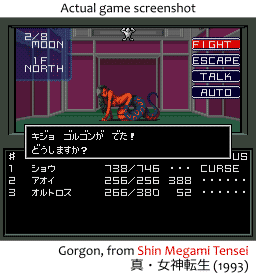
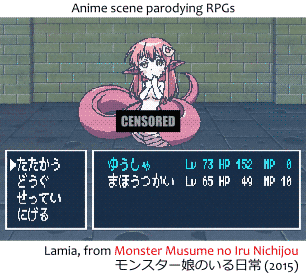




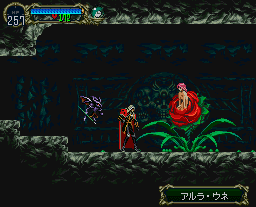



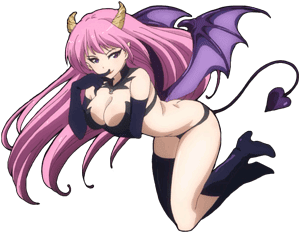
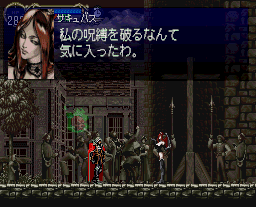


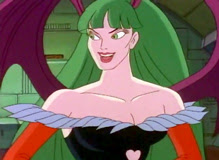
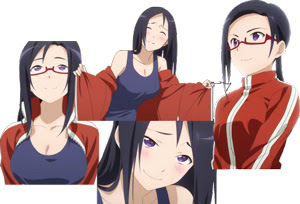



No comments: